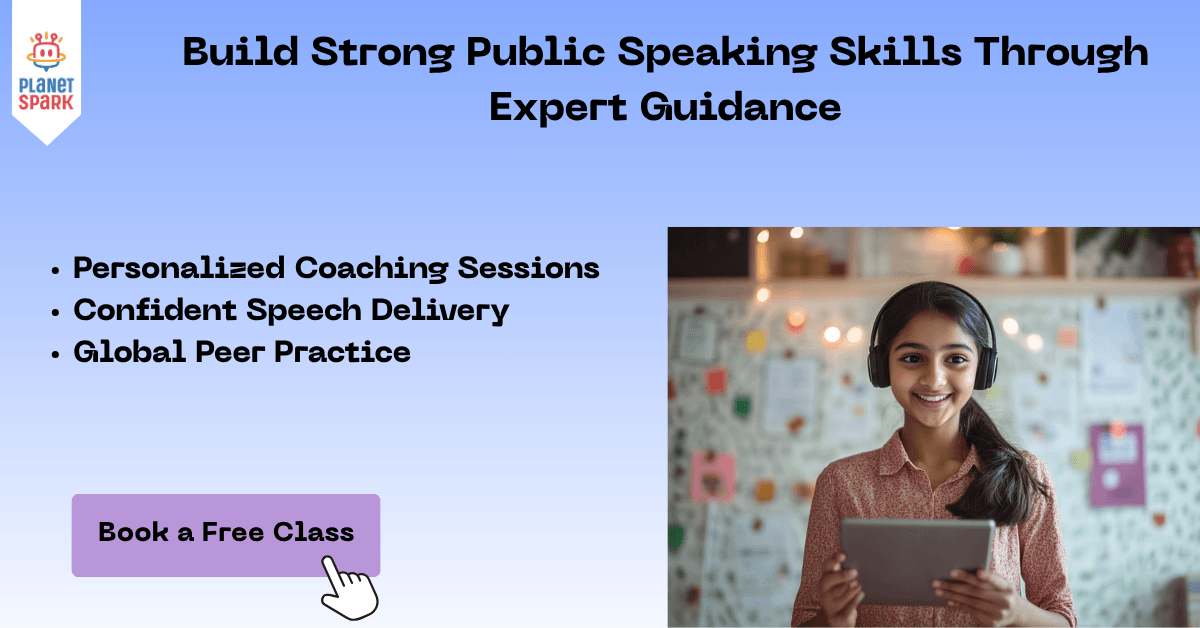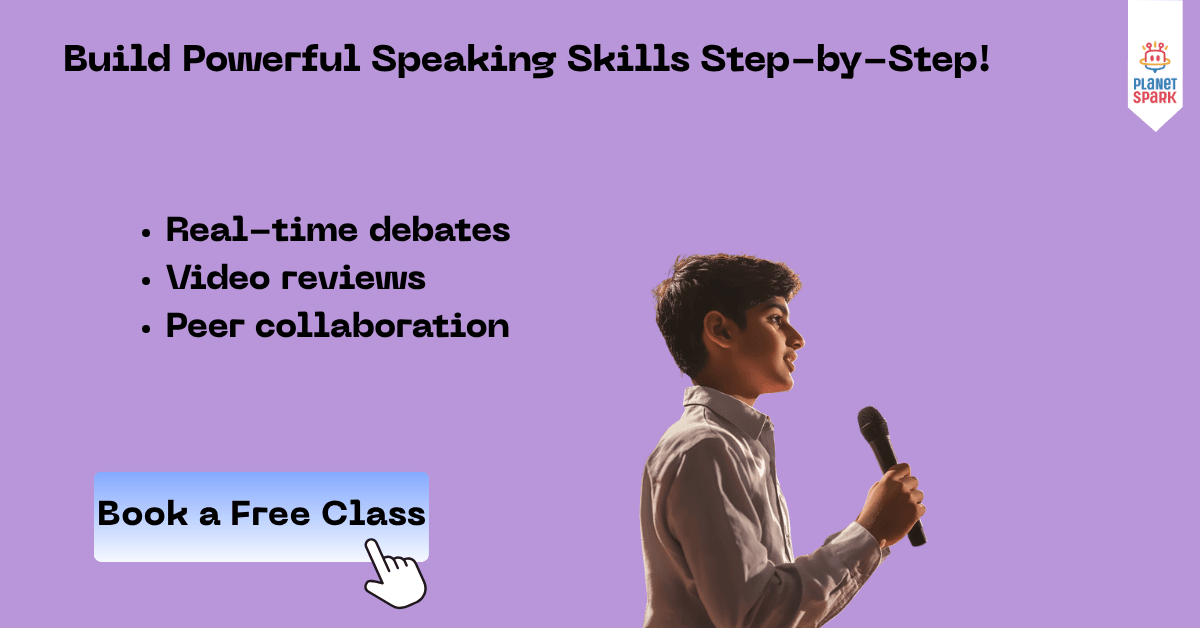Positive Body Language in Children for Communication

Table of Contents
- Why Body Language Matters for Children
- Building Confidence Through Positive Posture
- Eye Contact: The Key to Connection
- Encouraging Confident Posture
- Using Gestures to Express Ideas Clearly
- The Role of Facial Expressions in Communication
- Active Listening Through Body Language
- Building Confidence With Stage Presence
- Teaching Children the Importance of Space and Distance
- The Role of Body Language in Storytelling
- Teaching Mindful Breathing for Body Control
- Enhancing Group Communication Through Body Language
- Body Language in Classroom Participation
- Using Body Language in Friendships and Social Settings
- Body Language in Digital Communication
- Teaching Emotional Regulation Through Body Language
- Why Choose PlanetSpark?
Parents and teachers often emphasize vocabulary, grammar, and fluency when teaching communication skills. However, words alone are not enough—non-verbal cues often matter more. Studies show that nearly 55% of communication is non-verbal, highlighting the importance of body language in communication. For children, positive body language can be the difference between blending in and standing out in school, storytelling, or public speaking.
In this blog, we will explore why body language matters for children and how it shapes their communication journey. You will learn about eye contact, posture, gestures, facial expressions, and other essential aspects of body language. We’ll also discuss practical strategies for parents and teachers to help children develop these skills. This guide covers unique, non-repetitive topics like confidence-building, emotional expression, listening skills, and interaction etiquette aligned with public speaking and communication development.
By the end, you’ll discover how nurturing positive body language in your child can transform them into a confident, expressive, and effective communicator.

Why Body Language Matters for Children
Body language forms the foundation of how children connect with others. A child who makes eye contact, smiles, and maintains good posture is perceived as confident and approachable. On the other hand, closed-off gestures or slouching can unintentionally signal shyness, nervousness, or disinterest. Teaching children the importance of body language in communication ensures that they present themselves with confidence both in school and in social settings.
Moreover, positive body language not only impacts how others see the child but also how the child sees themselves. Adopting open gestures, standing tall, and speaking with expressive movements can boost self-esteem. These small yet powerful non-verbal cues help children feel more in control during presentations, group discussions, or even simple conversations with friends.
Building Confidence Through Positive Posture
Posture is one of the clearest indicators of confidence. Children who stand tall with their shoulders back naturally project self-assurance, even if they are nervous inside. Good posture also supports clear voice projection, which is essential for effective communication in classrooms or public speaking events.
Parents can encourage positive posture by creating small daily routines. For example, practicing storytelling while standing in front of a mirror helps children notice their stance. Role-playing as a teacher or a news presenter can also help them practice upright posture while speaking. Over time, this habit becomes part of their personality, strengthening both verbal and non-verbal communication.
Don’t let poor posture hold your child back!
Eye Contact: The Key to Connection
Eye contact is often called the window to trust and connection. For children, maintaining healthy eye contact during conversations helps them engage better with peers, teachers, and audiences. It signals attentiveness, respect, and confidence, qualities that are critical in both personal and academic interactions.
Simple activities, like practicing jokes while maintaining eye contact or reading aloud while looking at a family member, can train children to make eye contact naturally. This skill is especially important during public speaking, where eye contact keeps the audience engaged and conveys authenticity.
Encouraging Confident Posture
Posture speaks volumes before a child even says a word. Slouching or folding arms may unintentionally communicate shyness or discomfort, while standing upright signals assurance. Teaching children to balance their weight, keep their shoulders relaxed, and maintain an open stance helps them appear approachable and confident.
Simple posture exercises, such as practicing power poses or standing tall while reciting short stories, can instill a sense of physical awareness. These activities strengthen both verbal and non-verbal communication and gradually build lasting confidence.
Using Gestures to Express Ideas Clearly
Gestures add clarity and emphasis to communication. Children who use their hands to describe ideas not only appear more engaged but also make it easier for listeners to follow along. Teaching them natural and purposeful hand movements during conversations and presentations enhances their storytelling and communication skills.
Parents can encourage gestures through role-play activities, storytelling games, or even mirror exercises where children mimic expressive movements. These practices foster creativity while helping kids connect their words with actions.
The Role of Facial Expressions in Communication
Facial expressions are windows to emotions. A smile, frown, or raised eyebrows can speak louder than words. Helping children understand how their expressions affect conversations teaches them empathy and emotional awareness. Encouraging kids to practice emotions in front of a mirror or while acting out scenarios builds both confidence and expressiveness.
This skill proves especially useful in group activities, where conveying enthusiasm or understanding through expressions keeps communication engaging and authentic.

Active Listening Through Body Language
Good communication is not only about speaking, it is equally about listening. Active listening involves nodding, maintaining eye contact, and leaning slightly forward to show interest. Children who learn to listen attentively build stronger relationships and avoid misunderstandings.
Teaching kids the value of active listening can be done through interactive activities. For instance, in storytelling sessions, encourage children to mirror the emotions of the storyteller through their expressions. This not only boosts empathy but also makes them more mindful of how their body language impacts others.
Building Confidence With Stage Presence
Stage presence combines posture, gestures, and expressions into one powerful communication tool. Whether a child is reciting a poem, giving a presentation, or narrating a story, their body language plays a vital role in capturing attention. Parents can help children practice by recording their presentations and reviewing body language together.
This feedback loop helps children recognize small details such as fidgeting, lack of eye contact, or closed-off postures. By correcting these, they develop an engaging presence that sets them apart in classrooms and beyond.
Stage fright can hold children back! Secure a spot in PlanetSpark Public Speaking courses to help your child own the stage with confidence.
Teaching Children the Importance of Space and Distance
Personal space is a subtle but crucial part of body language. Standing too close may feel intrusive, while keeping an appropriate distance shows respect. Children who understand the concept of space communicate more comfortably in group settings.
You can teach children spatial awareness through role-play activities where they practice greetings, conversations, and group discussions while observing comfortable boundaries. This awareness not only improves communication but also nurtures social etiquette.
The Role of Body Language in Storytelling
Storytelling becomes captivating when children use their bodies effectively. Hand movements, expressive eyes, and dynamic gestures bring characters to life. Encouraging children to act out stories with exaggerated movements and expressions develops creativity while sharpening non-verbal communication.
Teachers can integrate drama exercises into classroom routines, while parents can organize short storytelling sessions at home. These practices make communication lively and help children break out of their shells.
Teaching Mindful Breathing for Body Control
Breathing techniques play a hidden but powerful role in communication. Nervousness often leads to shallow breathing, which affects both speech and body language. Teaching children deep breathing exercises helps them stay calm, control their gestures, and maintain a steady posture.
Practicing mindful breathing before presentations or conversations helps children appear more composed. Over time, this habit fosters resilience and a calm presence in high-pressure situations such as debates or stage performances.
Enhancing Group Communication Through Body Language
When working in groups, children must learn how to use body language to collaborate effectively. Open postures, nodding, and facing group members signal attentiveness and cooperation. On the other hand, crossed arms or avoiding eye contact may cause misunderstandings.
Group projects and team games offer the perfect environment to practice collaborative body language. By giving constructive feedback, parents and teachers can reinforce habits that make children reliable team players.
Collaboration is the key to success! Help your child master group communication in PlanetSpark Public Speaking programs.
Body Language in Classroom Participation
Active classroom participation is closely tied to body language. Raising hands confidently, sitting upright, and maintaining eye contact with teachers show eagerness to learn. When children use positive body language, teachers recognize them as attentive learners, leading to better engagement and opportunities.
Parents can encourage classroom confidence by role-playing typical situations like answering questions or giving short presentations at home. These simple practices prepare children for real-life classroom success.
Using Body Language in Friendships and Social Settings
Friendships thrive on open, warm communication. Smiling, using open gestures, and showing interest through body language help children form and sustain meaningful friendships. On the other hand, closed-off postures can discourage peers from initiating interactions.
Encouraging children to consciously use positive body language when meeting new friends, joining group activities, or resolving conflicts builds social confidence and emotional intelligence.
Body Language in Digital Communication
In today’s world, children often interact online through video calls or digital classrooms. Body language remains crucial even in virtual communication. Looking at the camera, smiling, and sitting upright enhance their online presence and help them connect better with peers and teachers.
Practicing online presentations or virtual role-plays at home can familiarize children with maintaining positive body language in digital spaces. This skill ensures they remain impactful communicators in both offline and online environments.
Teaching Emotional Regulation Through Body Language
Body language often reveals emotions even before words do. Teaching children to recognize when they are showing signs of nervousness, frustration, or boredom empowers them to regulate their behavior. Relaxed shoulders, deep breathing, and calm gestures can help manage emotional responses during challenging situations.
Parents and teachers can guide children with techniques like mirror practice, where they observe their expressions and postures to understand how emotions show physically. This builds both awareness and emotional control.

Developing positive body language in children is more than a communication skill; it is a foundation for confidence, self-expression, and success in academics and relationships. From posture and gestures to expressions and listening, every non-verbal cue shapes how children connect with the world around them.
By teaching these skills consistently, parents and educators empower children to grow into confident communicators. Whether in classrooms, friendships, or virtual spaces, strong body language ensures that children are always ready to engage meaningfully.
Why Choose PlanetSpark?
At PlanetSpark, we don’t just teach communication; we build confident young speakers who can articulate their thoughts, persuade with impact, and engage any audience. Here’s how we make it possible:
1:1 Public Speaking Coaching by Communication Experts
Every child receives personalized guidance from certified trainers in communication and child psychology. Individual attention ensures customized feedback and measurable growth.Step-by-Step Skill Building
Our structured curriculum covers everything: Body Language, Voice Modulation, Speech Structuring, Storytelling, Persuasive Techniques, Extempore Speaking, and Debating, so children gain skills in a progressive, confidence-boosting journey.TED-Style Training Modules
Children are coached to deliver impactful speeches using the same “hook, message, story, call-to-action” model followed by world-class TEDx speakers.Real-Time Practice with Global Peers
Students engage in live debates, panel discussions, storytelling circles, and group presentations with peers from 13+ countries, giving them unmatched global exposure.Public Speaking League & Competitions
Frequent competitions and a National-level Public Speaking League give children the thrill of real performance while sharpening their skills under pressure.Video Feedback Loop
Every child’s speech is recorded, reviewed, and analyzed with their coach to provide detailed, actionable feedback for continuous improvement.
Core Goal at PlanetSpark
To help every child build stage confidence, master articulation, deliver persuasive speeches, and engage audiences with impact.
Frequently Asked Questions
Body language is crucial because it enhances communication, builds confidence, and helps children express emotions even when words fall short.
Children can begin developing body language skills as early as preschool age. Simple gestures, eye contact, and posture awareness can be introduced through playful activities.
Parents can use role-playing, mirror exercises, storytelling, and games to make learning body language fun and interactive.
Positive body language strengthens stage presence, keeps audiences engaged, and helps children appear confident during presentations.
Yes. Positive body language practices such as standing tall, smiling, and making eye contact gradually help shy children build confidence and feel more comfortable in social settings.
Personalized Communication Report
Record a video to get a AI generated personalized communication report for your child

Hi There, want to try these
tips for your child with
LIVE with our expert coach?
Let's check your child's
English fluency
